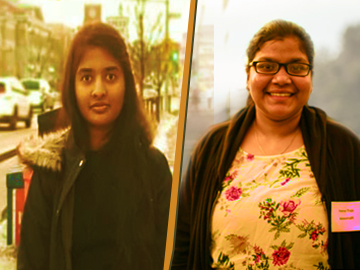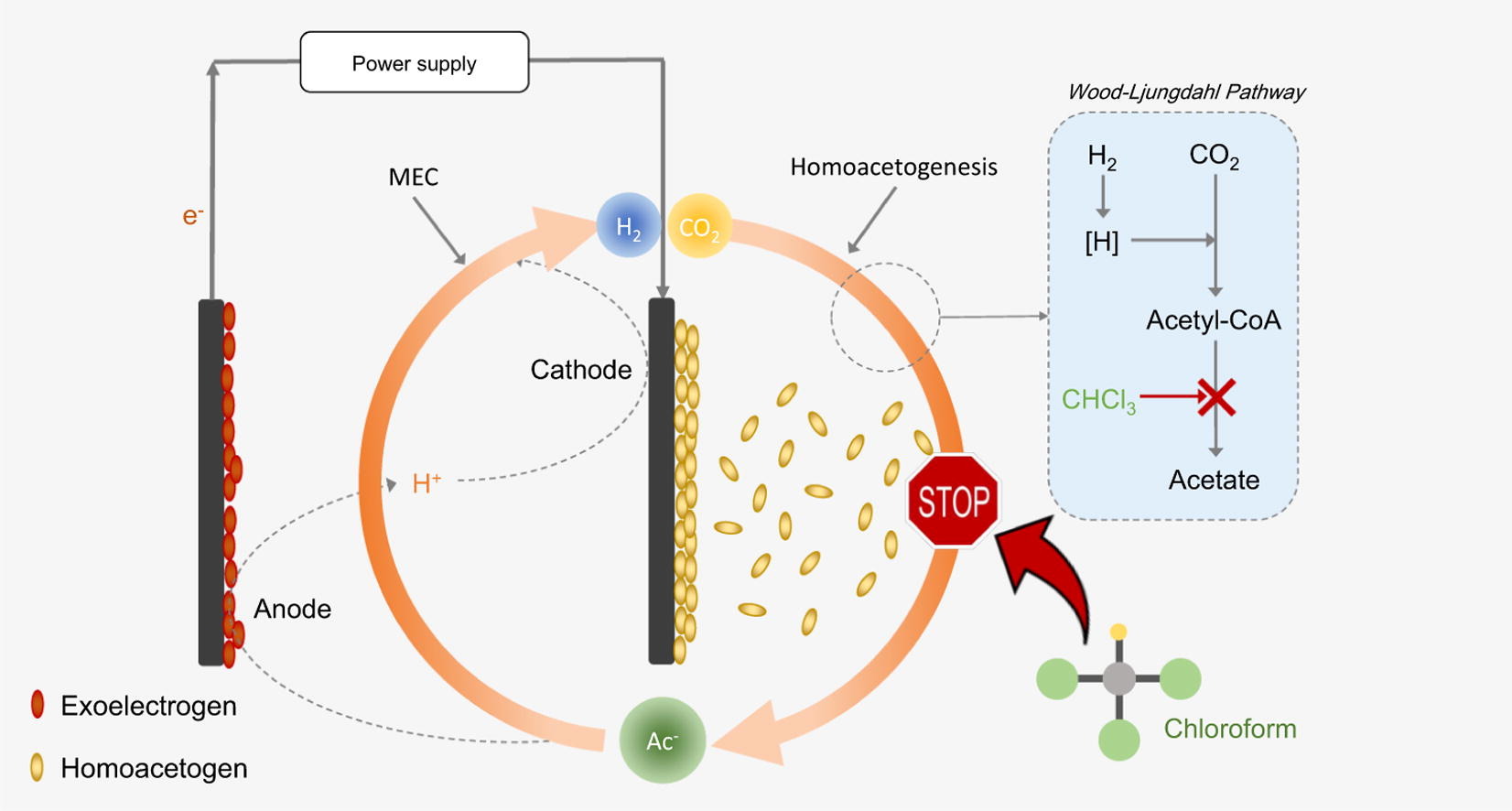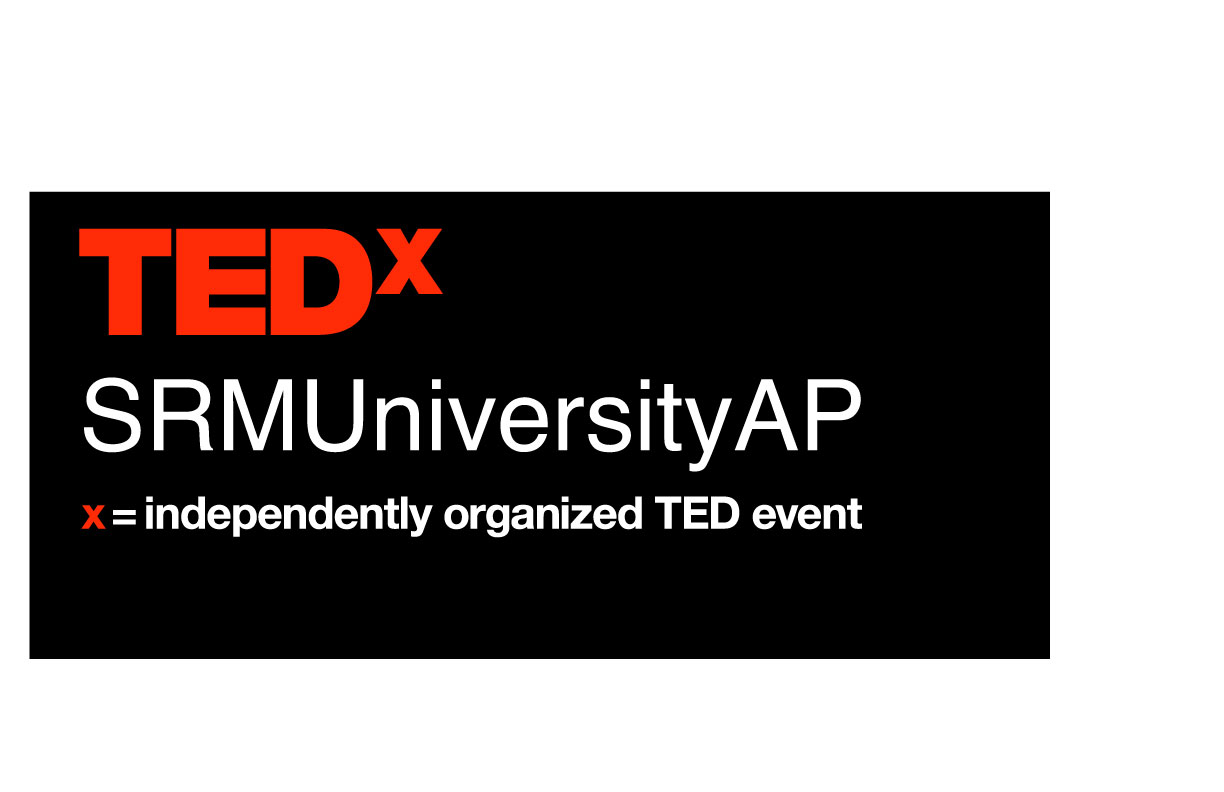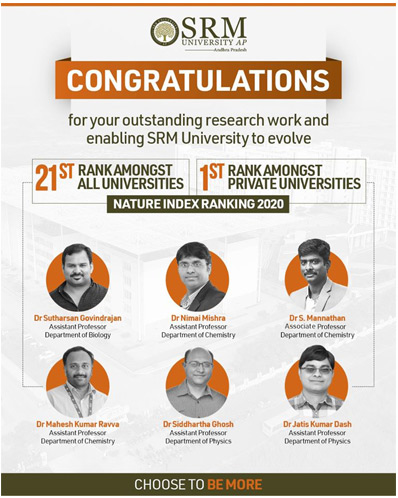SRM AP students’ illustrious achievements at LA Hacks 2020
 Amid the unparalleled catastrophe in the form of widespread COVID-19, SRM University AP, Andhra Pradesh, students at Semester Abroad Program develop projects to combat the crisis. Vyshnavi G and Padmateja, 3rd year, Computer Science and Engineering students went to University of Wisconsin, Madison, and University of California, Berkeley respectively for their Semester Abroad Program. During their stay, they presented two projects at LA Hacks 2020, Southern California, and won accolades galore. The hackathon is one of the largest in the world and was held on March 27-29. Many hackers and innovators participated to create and collaborate at UCLA’s virtual event. SRM AP students submitted two projects in this hackathon as a single team and emerged as a finalist in the “Best Overall Hack”. The students developed Safely, the project title sponsored by Facebook as “Best Collaboration Hack”, and also worked on Go Farm which was sponsored by Honey as “Best Consumer Hack”. The team coordinated through Slack as the hackathon was turned into a virtual competition with the unfortunate outbreak of COVID-19.
Amid the unparalleled catastrophe in the form of widespread COVID-19, SRM University AP, Andhra Pradesh, students at Semester Abroad Program develop projects to combat the crisis. Vyshnavi G and Padmateja, 3rd year, Computer Science and Engineering students went to University of Wisconsin, Madison, and University of California, Berkeley respectively for their Semester Abroad Program. During their stay, they presented two projects at LA Hacks 2020, Southern California, and won accolades galore. The hackathon is one of the largest in the world and was held on March 27-29. Many hackers and innovators participated to create and collaborate at UCLA’s virtual event. SRM AP students submitted two projects in this hackathon as a single team and emerged as a finalist in the “Best Overall Hack”. The students developed Safely, the project title sponsored by Facebook as “Best Collaboration Hack”, and also worked on Go Farm which was sponsored by Honey as “Best Consumer Hack”. The team coordinated through Slack as the hackathon was turned into a virtual competition with the unfortunate outbreak of COVID-19.
Safely is a society-based pandemic monitoring application for reporting and tracking precise geolocations of COVID-19 cases. Safely allows users to report their own condition, be it healthy, symptomatic, diagnosed, or recovered along with their geolocation. The application enables users to identify areas around them on a map. Based on the shade of the regions displayed on the map, the user deciphers the risk of contagion. Areas with symptomatic users display lighter shades, whereas locations with diagnosed patients and regions with a high concentration of affected users, show up as darker shades on the map. “With COVID-19 spreading rapidly, there are not enough resources to find or report the exact geographical information of new cases. People would want to be cautious by avoiding specific locations that have a lot of reported cases. Also, it enables help agencies to recognize areas where resources are required to be sent. Tracking COVID-19 can be especially difficult in developing countries with weaker infrastructure. “, Vyshnavi G explains the issues that inspired her to build this project.
GoFarm primarily benefits the farmers and improves consumer satisfaction. It is an application where a farmer can post information regarding harvested crops including vegetables, pulses along with quoting the price of the products. The customer can search for nearby farms using google maps and purchase through this platform. Padmateja says, “In India where agriculture sector employs more than 50% of the total workforce, we have come across many incidents in which farmers are suffering because of high debt burdens, corruption in subsidies, and crop failure. We thought to use our skills to develop an application that gives them profit. Not getting enough money for their crop is the most serious problem that they are facing right now. At the same time, we decided to emphasize on the consumer satisfaction. Eliminating third parties and connecting farmers with customers would be helpful in upgrading the agricultural sector. Due to COVID-19 outbreak, it has become more crucial for the consumers to be informed regarding stores responsible for the delivery of the product.”
In the future, the team wants to add a crop recommendation system for the farmers in the platform based on weather conditions. The students also plan to expand the availability of the application to many farmers and consumers across the nation.
- Published in News
Scaling up hydrogen production: an alternative energy source to conventional fuels
Chemical Engineering Journal publishes paper of Dr. Lakhveer Singh with Impact Factor 8.34
Dr. Lakhveer Singh, Assistant Professor, Department of Environmental Science, SRM University AP, Andhra Pradesh published a paper in the Chemical Engineering Journal with an Impact Factor of 8.34. His paper titled, Breaking the Loop: Tackling Homoacetogenesis by Chloroform to Halt Hydrogen Production-Consumption Loop in Single Chamber Microbial Electrolysis Cells is published in collaboration with Oregon State University.
Single Chamber Microbial Electrochemical Cells reactor is used to produce hydrogen. Since wastewater is used in the process, hydrogen consumers are present inside the reactors. The presence of homo acetogenesis and hydrogen production-consumption loop significantly hinders the efficient hydrogen recovery from this reactor. Removal of homo acetogenins remained a challenge that is mitigated by the research work conducted in this paper. Dr. Lakhveer informs, “Prof. Hong Liu is the mother of the bioelectrochemical system. I used to work with her for 1.5 years during my Post Doctorate. We developed the method to inhibit homo acetogenins in bioelectrochemical fuel cells for the first time to exhibit homo acetogenins which enhance the hydrogen production in scaled-up microbial electrochemical (MEC).”
 Method to inhibit homo acetogenins in bioelectrochemical fuel cells
Method to inhibit homo acetogenins in bioelectrochemical fuel cells
A small concentration of chloroform is used in the process, which after the experiment leaves traces of merely 0.001% which is negligible. Furthermore, 0.02 ml chloroform is used in ten litres of reactors, negating the chance of causing damage to the environment. “Microbial community analysis revealed that the amount ofhomoacetogenic Acetobacterium spp. was eliminated in the cathodic biofilms and planktonic cells by chloroform.”, enlightens Dr. Lakhveer. This method can also be applied in large scale reactors to enhance hydrogen production by inhibiting homo acetogenins. The hydrogen production rate is nearly 20 litres per hour from the reactor. The application of this reactor is the production of energy which can be used as an alternative to conventional fuel.
Advancing the work, Dr. Lakhveer aspires to improve this method in the future, through reducing the residual chloroform concentration and developing more environment-friendly inhibitor using similar mechanisms, that may lead to the practical application in MECs.
- Published in News, Research News
SRM-AP’s liaison with TEDx to promote active thinking
 Globally, TEDx events are incredibly appealing for their cutting-edge and progressive ideas from the speakers. TEDx carefully curates, magnifies, and develops these ideas, that can genuinely change the world for the better. SRM University AP now joins the TEDx community to take it to an entirely new level.
Globally, TEDx events are incredibly appealing for their cutting-edge and progressive ideas from the speakers. TEDx carefully curates, magnifies, and develops these ideas, that can genuinely change the world for the better. SRM University AP now joins the TEDx community to take it to an entirely new level.
A TEDx event is a local gathering where live TED-like talks and performances are shared with the community. TEDx events are thoroughly planned and coordinated independently, on a community-by-community basis. The content and design of each TEDx event is unique and developed independently, but all of them are expected to abide by the standards and rules set by TED. This event can be extremely advantageous to the university not only in terms of the knowledge that the talks bring but because of the ambience, optics & publicity that it provides.

“We’ve been working towards acquiring the license for months, and we are pleased to inform that our application for TEDxSRMUniversityAP has finally been approved! The application process involved presenting our ideas and defending the questions by the representatives at TED. Overall, it was a good experience,” said Dr Bhanukiran, Assistant Professor in the Department of Computer Science and Engineering. This license permits SRM University- AP to organise one TEDx event within the next 12 months which means it is valid till May 12, 2021, and allows an attendee limit up to 100.
SRM University- AP is now setting up a dedicated website for the event where all the information will soon be announced. The students, staff and faculty are all thrilled to facilitate the event. The TEDx team will meet soon to discuss and finalise the details of the event.
- Published in Announcements, Collaborations, News
SRMAP’s contribution made SRMIST the No.1 private university in India
The very young SRM University-AP is already creating marvels by scaling new heights as a multidisciplinary research university. The 3-year-old university has published six very impactful research papers in a year in Nature Indexed journals. The notable research work helped significantly its sister aka principal institution SRM Institution of Science and Technology acquiring the rank of No.1 private university in India and 21 among Indian universities by the Nature Index 2020. The ranking was done based on Nature Index data from January 1st 2019 to December 31st 2019.

The Nature Index provides a perspective on high –quality research on the basis of published articles. The Nature Index provides a close to real-time proxy of high-quality research output and collaboration.
Nineteen research articles were published by the faculty members of SRMIST and its sister institutes between April 1st 2019 and March 31st 2020. These articles were compiled into a database by Nature Research to create the Nature Index rankings. Out of these nineteen articles, twelve were published by the Faculty Members of SRMIST, KTR Campus. One article was published by a faculty member of SRM University – Sikkim. The rest of the six articles were published by faculty members of SRM University- AP, Andhra Pradesh. Dr Sutharsan Govindrajan, Department of Biological Sciences; Dr Nimai Mishra, Dr S. Mannathan, Dr Mahesh Kumar Ravva, Department of Chemistry; Dr Siddhartha Ghosh and Dr Jatis Kumar Dash, Department of Physics played a pivotal role in achieving the honour for SRM University-AP. It is remarkable that SRM-AP, even in its budding stage, has contributed to around one third of the Nature Index score.
Dr Sutharsan’s paper, “A bacteriophage nucleus-like compartment shields DNA from CRISPR nucleases”, published in Nature, involves the discovery of novel strategies used by bacteriophages (viruses that kill bacteria) to overcome the bacterial CRISPR-Cas system, which are molecular scissors that are programmed to cut DNA. His findings have massive implications on the society as it has the ability to reshape the boundaries of the Phage-therapy in curing diseases.
Dr Mishra has published a paper titled “Broadband Defects Emission and Enhanced Ligand Raman Scattering in 0D Cs3Bi2I9 Colloidal Nanocrystals”. It is about excitonic 0D and 2D lead-halide perovskites that have been recently developed and investigated as new materials for light generation. In this work, a broadband (>1 eV) emission from newly synthesised 0D lead-free colloidal Cs3Bi2I9 nanocrystals (NCs) is reported. Remarkably, evidence of enhanced Raman scattering from the ligands is observed when attached to the NCs surface, an effect that is preliminarily attributed to strong exciton-ligands electronic coupling in these systems. Such interesting properties can be extremely appealing for a new class of low-cost materials suitable for solid-state lightning and sensing applications.
Dr Mannathan’s research article, “Palladium/Copper-Catalyzed Denitrogenative Alkylidenation and ortho-Alkynylation Reaction of 1,2,3-Benzotriazin-4(3H)-ones”, describes an environmentally friendly strategy to access various functionalised isoindolinones and 3-(imino)isobenzofuranones, which are important backbone in many natural products and biological active compounds. These reactions were enabled by an interesting Pd/Cu-cocatalyzed denitrogenative tandem alkynylation/cyclisation sequence. The strategy was also successfully employed to synthesise (Z)-3-benzylideneisobenzofuran-1(3H)-one derivatives in good to high yields.
Dr Mahesh’s paper is named “Harnessing Autoxidation of Aldehydes: In Situ Iodoarene Catalyzed Synthesis of Substituted 1,3,4-Oxadiazole, in the Presence of Molecular Oxygen”. In this study, a new methodology has been developed for the synthesis of substituted 1,3,4-oxadiazoles, which are essential pharmaceutical ingredients. We have modelled the reactivity of reactants, reactive intermediates, and products using computational protocols. Results obtained from these computational protocols are used to predict the reaction pathways and gain insights on the stability of products.
Dr Ghosh published “Direct Growth of Wafer-Scale, Transparent, p-Type Reduced-Graphene-Oxide-like Thin Films by Pulsed Laser Deposition”. His study reveals that reduced graphene oxide (rGO) is a derivative of widely used 2-D material called Graphene. Along with Graphene itself, rGO is also an exciting material for research communities due to its potential application in gas sensing, water purification and desalination, energy storage and flexible electronics. All these novel applications require a reproducible & scalable growth process for rGO thin films. In their research article, they have reported a single-step bottom-up growth process of reduced Graphene Oxide using a thin-film growth technique called Pulsed Laser Deposition (PLD). Utilising the state-of-the-art laser beam scanning technology, they have been able to grow 4-inch wafer-scale rGO thin-films with ultra-smooth surfaces and unparallel thickness uniformity. Moreover, they have found that these rGO thin-films are transparent and conducting with some of the lowest extinction coefficients and refractive index values. They believe this novel growth process combined with the exotic opto-electronic properties (of rGO) will enable us to directly grow and integrate rGO thin-films on Si & metal-oxide based hetero-structures and will potentially move forward the rapid deployment of rGO for various applications.
Dr Dash’s article is titled as “Thickness-Insensitive Properties of α-MoO3 Nanosheets by Weak Interlayer Coupling”. Extensive use of portable electronic products and the rapidly growing commercial markets in smart electric appliances have created a seemingly high demand for flexible, wearable and foldable high-performance photoelectric devices. In the search for new materials to meet these criteria, one promising solution may be the two-dimensional (2D) layered heterostructures, assembled by stacking different conventional 2D materials in hetero-layered architectures. Alpha (α) phase-molybdenum trioxide (MoO3) is one of the promising 2D oxides, which is a chemically stable semiconductor with a high dielectric constant. The high resistive tunnelling and dielectric constant also shows that α- MoO3 nanosheet can be used as a promising dielectric or tunnel barrier. Therefore, the epitaxially grown MoO3 can be an important candidate in the field of 2D materials-based nanoelectronics. α- MoO3 layers can also be used as dielectrics for supercapacitors, and channel materials for high power electronics. Besides these, heterojunctions like Graphene-α- MoO3 and α- MoO3 /MoS2 has its applications in Field effect transistors (FETs), battery cathode materials, and various sensors.
The Nature Index is a database of author affiliations and institutional relationships. The index tracks contributions to research articles published in 82 high-quality natural science journals, chosen by an independent group of researchers. This Index provides absolute and fractional counts of article publication at the institutional and national level and, as such, is an indicator of global high-quality research output and collaboration.
- Published in News


